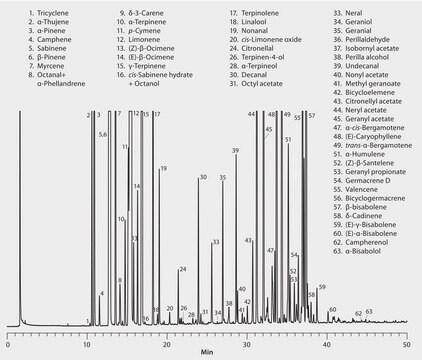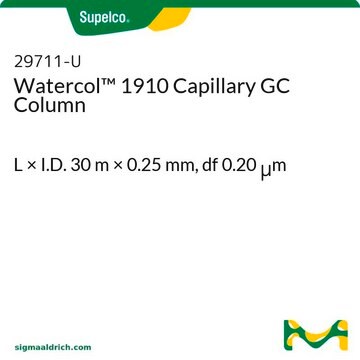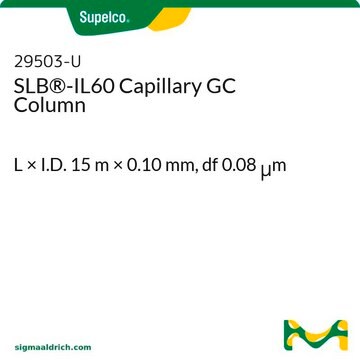Wichtige Dokumente
29799-U
SLB®-ILPAH Capillary GC Column
L × I.D. 20 m × 0.18 mm, df 0.05 μm
About This Item
Empfohlene Produkte
Materialien
fused silica
Qualitätsniveau
Parameter
≤25-300 °C temperature (isothermal or programmed)
Beta-Wert
900
df
0.05 μm
Methode(n)
gas chromatography (GC): suitable
L × ID
20 m × 0.18 mm
Aktive Matrixgruppe
Non-bonded; 1,12-di(tripropylphosphonium)dodecane bis(trifluoromethanesulfonyl)imide phase
Anwendung(en)
food and beverages
Säulenart
capillary polar
Suchen Sie nach ähnlichen Produkten? Aufrufen Leitfaden zum Produktvergleich
Verwandte Kategorien
Allgemeine Beschreibung
USP Code: None
Phase: Non-bonded; 1,12-Di(tripropylphosphonium)dodecane bis(trifluoromethanesulfonyl)imide
Temp. Limits: Subambient to 300 °C (isothermal or programmed)
Anwendung
This study investigates the retention behavior of polycyclic aromatic sulfur heterocycles (PASHs) using gas chromatography with different stationary phases, including ionic liquids (ILs). The IL phase demonstrated unique selectivity and correlation with PASH geometry. (Wilson, Lee, et al, 2017)
https://doi.org/10.1016/j.chroma.2017.01.026
Retention behavior of isomeric polycyclic aromatic sulfur heterocycles in gas chromatography on stationary phases of different selectivity
The research evaluates the gas chromatographic retention indices of alkyl-substituted PASHs using various stationary phases, including ionic liquids. Results indicate that ILs offer distinct selectivity and thermal stability, enhancing the separation of complex mixtures.
(Wilson, Lee, et al, 2017)
https://doi.org/10.1016/j.chroma.2017.01.024
Ultra-high thermal stability perarylated ionic liquids as gas chromatographic stationary phases for the selective separation of polyaromatic hydrocarbons and polychlorinated biphenyls
This article explores the use of perarylated ionic liquids as stationary phases in gas chromatography for separating polycyclic aromatic hydrocarbons and polychlorinated biphenyls. The ILs exhibit high thermal stability and unique selectivity, improving the resolution of challenging analytes.
(Anderson & Davis, 2019)
https://doi.org/10.1016/j.chroma.2
Rechtliche Hinweise
Lagerklassenschlüssel
11 - Combustible Solids
WGK
WGK 3
Flammpunkt (°F)
Not applicable
Flammpunkt (°C)
Not applicable
Hier finden Sie alle aktuellen Versionen:
Besitzen Sie dieses Produkt bereits?
In der Dokumentenbibliothek finden Sie die Dokumentation zu den Produkten, die Sie kürzlich erworben haben.
Protokolle
ionic liquids can successfully be used as viable GC stationary phases. These consist of two or more organic cations joined by a linkage, and associated with... improved inertness for polar analytes was the inspiration for the development of SLB™-IL (i-series) ionic liquid capillary GC columns. They solve a dilemma.
Unser Team von Wissenschaftlern verfügt über Erfahrung in allen Forschungsbereichen einschließlich Life Science, Materialwissenschaften, chemischer Synthese, Chromatographie, Analytik und vielen mehr..
Setzen Sie sich mit dem technischen Dienst in Verbindung.







